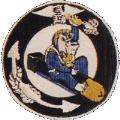| Marine Attack Squadron 143 | |
|---|---|
 VMTB-143 Insignia | |
| Active | 7 September 1942 – 10 March 1946 [1] |
| Country | United States |
| Allegiance | United States of America |
| Branch | United States Marine Corps |
| Type | Fighter squadron |
| Role | Air interdiction close air support |
| Part of | Inactive |
| Nickname(s) | Rocket Raiders |
| Engagements | World War II |
Marine Attack Squadron 143 (VMA-143), nicknamed the Rocket Raiders, was a reserve attack squadron in the United States Marine Corps. Originally commissioned during World War II, the squadron fought at the Guadalcanal, New Georgia, the Battle of Bougainville, Battle of Okinawa, and the Battle of Balikpapan.